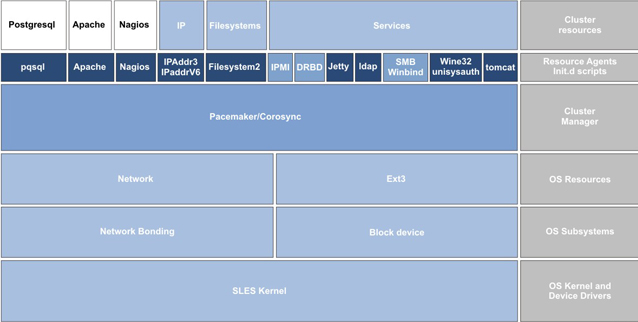Note: You use the ClearPath Forward Fabric Management Platform web-based graphical user interface (FMP Manager user interface) to configure and manage a high availability cluster. For more information on the FMP Manager user interface, see ???.
The Unisys high availability capability is built on the SUSE® LINUX Enterprise High Availability Extension suite of open source clustering technologies. The key component from the SUSE High Availability extension package delivered with the Unisys high availability capability is the Distributed Block Replication Device (DRBD) software that allows for data replication of the Fabric Manager data.
The key components unique to the Unisys high availability capability are
The FMP Manager user interface for configuring the Fabric Manager cluster and managing cluster services
Enhanced Resource Agents to monitor the availability of Fabric Manager resources
Predefined Fabric Manager high availability cluster configuration
Push button setup for the Fabric Manager high availability cluster using the FMP Manager user interface.
The Unisys high availability capability integrates with open source technologies and enables you to support the Fabric Manager workload in a highly available manner, eliminating single points of failure. The high availability capability automatically shares cluster configuration, replicates management data, and coordinates cluster-wide activities to ensure predictable behavior in protecting your management resources.
The Unisys highly available Fabric Manager uses several modules such as services, resources agents, network and file availability as well as a stable Linux kernel. The following figure shows the Unisys supplied resource agents in dark blue; the SLES High Availability Extension package components in medium blue; and the operating system resources, subsystems, kernel, and device drivers provided by the SLES kernel in gray.

The first node of your highly available cluster is configured on site, and then a second Fabric Manager node is joined to the existing cluster. Once the cluster is created, then the Fabric Manager resources are added.